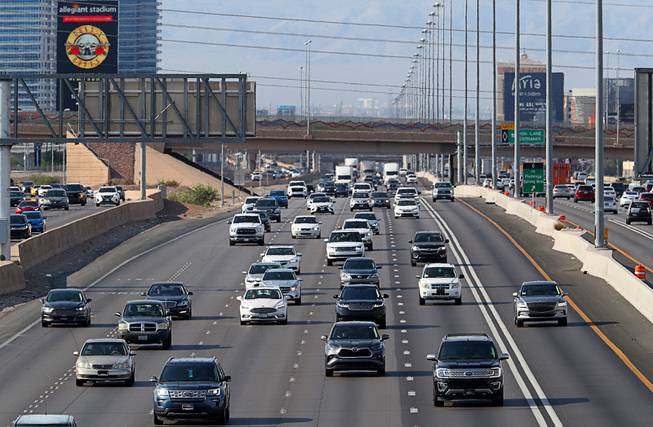
Traffic heads southbound on I-15 near Sunset Road Sunday, July 25, 2021. As Southern Californians head home on Sundays from their weekends in Las Vegas, congestion south of the city on I-15 can bring traffic to a near standstill.
Sunday, Aug. 1, 2021 | 2 a.m.
Jim Nares is all too familiar with the Sunday morning routine of waking up early in his Las Vegas hotel room to get a head start on the drive back to Southern California via Interstate 15.
Sleeping in poses a seemingly unavoidable hurdle: Long hours stuck in traffic getting home to Winchester, Calif.
Nares has been traveling by car with his wife to Las Vegas for 20 years for outdoor recreation, restaurants and light gambling. To keep the return drive at the minimum of four hours, Nares opts for either an early-morning departure or late-night arrival back home.
Leaving in the afternoon when thousands of others hit the road is out of the question, he says.
“I don’t like traveling back on Sunday,” he said. “Sometimes it just happens. … If we do, we definitely try to be past state line by 9 a.m., otherwise we just stick around (Las Vegas) until, like, 6, 7 p.m.”
The parade of bumper-to-bumper traffic is a Sunday afternoon ritual heading back to California. Residents of California accounted for 21% of visitors to Las Vegas in 2019, according to the most recent Visitor Profile Study by the Las Vegas Convention and Visitors Authority. During the pandemic when air travel was limited because of safety concerns, drive-in visitors from California helped keep the local economy moving.
Having those visitors stalled in traffic is concerning, Clark County Commissioner Tick Segerblom said. After all, the last impression of someone’s visit shouldn’t be delays on the road.
“It’s not healthy to have that kind of backed-up traffic,” he said. “To be stuck in … back-to-back traffic, their memory of Las Vegas is not going to be positive.”
The typical travel time from Las Vegas to San Bernardino County should be about 3.5 hours. But on weekends and holidays, that time can be doubled. And when considering $95 billion worth of commerce flows through local communities as well as national and global markets on the I-15, alleviating traffic congestion is on the radar of officials.
Most of I-15 from Las Vegas to the California state line is at least six lanes — three southbound, three northbound — but the road narrows at Primm, just before the state line, where traffic can slow and backup, with the congestion continuing well into California as a mostly two-lane southbound thoroughfare.
Solutions prove trickier, especially because two states are involved. One proposal, a $1.4 billion project outlined by the city of Las Vegas, would expand 114 miles of the interstate from Primm to Barstow, Calif., from four to six lanes. But because Primm abuts the California state line, this project would need to be funded by the California Department of Transportation (Caltrans), said Jace Radke, a Las Vegas spokesman.
In a tweet Wednesday, Las Vegas Mayor Carolyn Goodman again called on California representatives to adopt a solution that would increase the number of lanes to abate traffic tie-ups.
On Nevada’s side, an $11 million project to repave a 16-mile section of I-15 from Primm to north of Jean in Clark County was approved in May, said Tony Illia, spokesman for the Nevada Department of Transportation. The project will not add new lanes to I-15 but instead maintain the highway’s integrity and avoid future repairs, he said.
“The problem lies in California where traffic is choked down to two lanes in each direction after crossing state line, resulting in backups,” Illia wrote in an email. “Although we continue to have an encouraging ongoing dialogue with Caltrans, their transportation spending priorities don’t necessarily align with those of Nevada.”
One California arrangement comes from Brightline West, which intends to construct a $5 billion high-speed electric rail line from Las Vegas to Southern California that could carry 11 million passengers annually. Trains with up to 500 passengers, would move at speeds up to 200 mph and run parallel to I-15. Last month, a holding company for Brightline West purchased 110 acres of land near the Strip to build a terminal station, but plans are uncertain.
Ground was scheduled to be broken for the Vegas-to-California route last year, but Caltrans pulled the plug on a planned $600 million private activity bond allocation, which was supposed to raise up to $2.4 billion for the project.
San Bernardino County Transportation Authority is also collaborating with Brightline West to connect it with the San Bernardino Line of Metrolink in Rancho Cucamonga, as well as adding a line from Victor Valley to the San Bernardino Valley. This would add some additional relief, according to Terri Kasinga, a public affairs officer with Caltrans.
Segerblom said he was skeptical of the impact of the rail system and would prefer projects that add additional lanes to the highway.
“There’s no better investment than to add one or two lanes more to I-15,” he said. “If we’re going to build the railroad, why not add the lanes at the same time?”
Despite the backups on I-15, Californians like Nares continue to flock to Las Vegas. Although the traffic can be unbearable, it would not dissuade Nares from traveling to Las Vegas, he said. He and his wife do not mind long drives and typically accompany their rides with ’70s, country or jazz music.
“The traffic’s not what would discourage me at all,” he said. “I guess if I had to go every Sunday and every Friday it might discourage me a little bit, but we have fun, and we enjoy talking in the car. … If it gets real bad, we’ll pull over, like at Barstow … and wait till the traffic dies down. We’re in no hurry usually.”
